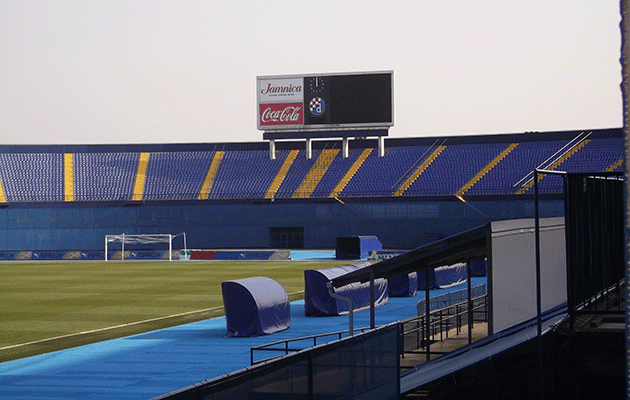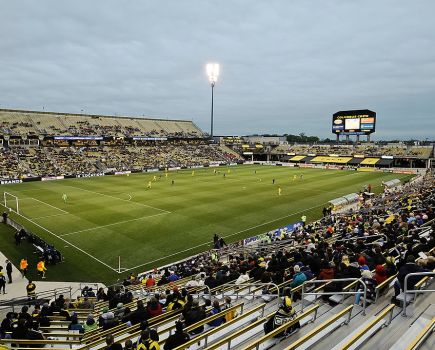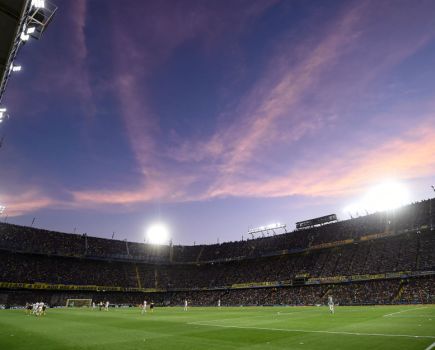Zagreb is one of 150 soccer cities featured in Libero, the digital travel guide for football fans. Regularly refreshed with new destinations and the travelogue Soccer Sagas, Libero is a one-click treasure trove of football trip tips, tales and trivia. See www.liberoguide.com/zagreb.
Maksimir Stadium, Dinamo Zagreb v Arsenal, Champions League, Wed Sept 16/2045 CET-1945 UK time
Croatia’s capital Zagreb is home to flagship club Dinamo, recently crowned ten-time league champions.
Set alongside the park of the same name, named after the local bishop who established this area of greenery open to the public in the late 1700s, Maksimir has been a stage for local soccer for 100 years.
Organised football was first played here in 1912, the year the Croatian FA was formed. Of the city’s top three clubs of the pre-war era, Gradjanski, Concordia and HASK, it was the latter who considered the Maksimir as their home ground.
As for the nascent Yugoslav national side, then representing the country known as the Kingdom of the Serbs, Croats and Slovenes, when in Zagreb they mainly used the Stadion u Kranjcevicevoj, now home to NK Zagreb.
But when Dinamo were formed from the disbandment of the city’s big three in June 1945, Maksimir became their home and the main focus for football in Zagreb.
It was here that Dinamo staged three successful Yugoslav League campaigns and here that The ‘Plavi’ overcame Leeds in the first leg of the successful Fairs’ Cup win of 1967.
And it was also here, one sunny May afternoon in 1990, that Dinamo’s notorious Bad Blue Boys took on their equally notorious counterparts from Red Star Belgrade, the Delije, fans fighting on the pitch at a Yugoslav league game between the two. The riot is seen as a symbolic prelude to the full-scale war that would break out between Serbs and Croats a year or so later. It is also known for the kick that Dinamo hero Zvonimir Boban aimed at a policeman (who turned out to be a Bosnian Muslim), springing to the defence of a Dinamo fan.

Zvonimir Boban, right, clashes with police during the Yugoslav league soccer match between Belgrade’s Red Star and Zagreb’s Dinamo
Since the break-up of Yugoslavia, despite a number of name changes, Dinamo have near dominated the independent Croatian league. Only derby games with Hajduk Split, and occasional European games, see the Maksimir in its pomp.
For the Croatian national side, games with Serbia (October 1999, a 2-2 draw that sent the visitors to Euro 2000) and England (October 2006, a hilarious gaffe by goalkeeper Paul Robinson) have proved the most memorable – the Maksimir is the de facto national stadium.
Renovations are currently ongoing. In the wake of Croatia’s success at the 1998 World Cup, an ambitious plan for a complete overhaul only got as far as the rebuilding of a new North Stand. Ten years later, another, cheaper, blueprint was reviewed. The 2011 installation of a new turf and seats is seen as the first step in a gradual, more modest programme of redevelopment.
 But with Croatian league attendances below an overall average of 2,000, travelling support for domestic fixtures is modest at best. Sadly, the Maksimir hardly fills for Croatia internationals, either – and rental for regular hosts Dinamo is steep.
But with Croatian league attendances below an overall average of 2,000, travelling support for domestic fixtures is modest at best. Sadly, the Maksimir hardly fills for Croatia internationals, either – and rental for regular hosts Dinamo is steep.
On the ground
Take tram Nos.4, 5, 7, 11 or 12 to Bukovacka, the stop right by the Maksimir Stadium. Nos.11 and 12 run from the main square, Trg bana josipa Jelacica; No.4 runs from the train station, Glavni kolodvor.
There’s a ticket hut in the stadium’s main forecourt.
For Champions League matches in 2015-16, prices have been set at 300kn-400kn behind each goal and 500kn in the West (Zapad) Stand. Details can be found here but registration is required.
Prices drop considerably for lesser league fixtures, when 40kn should secure you a ticket.
For a Dinamo derby with Hajduk, prices are set at 100kn for best seats in the West Stand, 70kn in the East Stand opposite, and 50kn in the home North (Sjever) end.
 The Maksimir comprises four stands: the main West one (Tribina Zapad) and the Tribina Istok (East) facing it along the sidelines; the home North end and the South (Jug) one opposite, where visiting fans are generally gathered.
The Maksimir comprises four stands: the main West one (Tribina Zapad) and the Tribina Istok (East) facing it along the sidelines; the home North end and the South (Jug) one opposite, where visiting fans are generally gathered.
As you approach the stadium on the main road, bars line Maksimirska cesta.
To the left, just inside the park gates, the Restoran Maksimir is a lovely restaurant and terrace bar, tables spread out on a wide, gravel space backdropped by trees. There’s a full Croatian menu too, including the Zagreb specialities of strukli pastry, breaded meat and a hulking great house platter for two hungry carnivores.
At the stadium, behind where the West (‘Zapad’) and South (‘Jug’) Stands meet, there are two outlets. The Stara kotlovnica was closed during the recent renovations – but the classic Restoran Domagoj is very much open, the vintage wooden interior of its bar a de facto Dinamo museum. Classic black-and-white images include one of coach Ciro Blazevic and former national president Franjo Tudjman in a pre-kiss pose, one of the Dinamo side of 1967, and several of local heroes Zvone Boban and Davor Suker. Visits by Pelé and Cruyff are also illustrated. In the large adjoining restaurant, steaks and cutlets are served alongside Bavaria beer.









